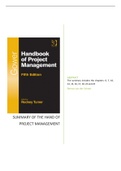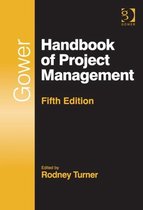Samenvatting
Samenvatting Gower Handbook of Project Management, ISBN: 9781472422965 Projectmanagement methoden en standaarden (MPM-PM-PMMS-22_1)
Instelling
Hogeschool Utrecht (HU)
Een samenvatting van de volgende hoofdstukken van het boek the handbook of project management (fifth edition): 6, 7, 10, 14, 15, 16, 17, 18, 22, 25.
Gemaakt voor het vak projectmanagement methoden en standaarden (PMMS) en Agile en Hybride projectmanagement (AHP) voor de master projectmanagement...
[Meer zien]
Laatste update van het document: 1 jaar geleden
Voorbeeld 4 van de 62 pagina's
Heel boek samengevat?
Nee
Wat is er van het boek samengevat?
Chapter, 6, 7, 10, 14, 15, 16, 17, 18, 22, 25
Geupload op
7 oktober 2022
Bestand laatst geupdate op
4 april 2023
Aantal pagina's
62
Geschreven in
2022/2023
Type
Samenvatting
progressive elaboration
scope creep
defining scope
wbs
pbs
work packages
configuration management
life cy
managing scope and configuration
scope definition chain and errors
scope identification errors
Titel boek: Gower Handbook of Project Management
Auteur(s): Rodney Turner
Uitgave: 2014 ISBN: 9781472422965 Druk: 5
Samenvatting
Agile en Hybride samenvatting scrum + gower + slides
Samenvatting
Summary of chapter 6 Gower Handbook of Project Management - Agile and Hybrid Project Management
Samenvatting
Summary of chapter 7 'measuring performance' from the Gower Handbook of project management
Alles voor dit studieboek (13)
Instelling
Hogeschool Utrecht (HU)
Studie
Master projectmanagement
Vak
Projectmanagement methoden en standaarden (MPMPMPMMS22_1)
Alle documenten voor dit vak (16)
€6,99
Ook beschikbaar in voordeelbundel v.a. €6,99
100% tevredenheidsgarantie
Direct beschikbaar na betaling
Zowel online als in PDF
Je zit nergens aan vast
Ook beschikbaar in voordeelbundel (2)
Samenvatting Gower Handbook of Project Management, ISBN: 9781472422965 Projectmanagement methoden en standaarden (MPM-PM-PMMS-22_1)
1. Samenvatting - Samenvatting gower handbook of project management, isbn: 9781472422965 projectmanage...
2. Samenvatting - Chapter 10 'managing scope and configurations' gower handbook of project management, ...
3. Samenvatting - Chapter 14 'managing for stakeholders' gower handbook of project management, isbn: 97...
4. Samenvatting - Chapter 15 'managing the schedule' gower handbook of project management, isbn: 978147...
5. Samenvatting - Chapter 17 'managing resources' gower handbook of project management, isbn: 978147242...
6. Samenvatting - Chapter 18 'managing risk' gower handbook of project management, isbn: 9781472422965
7. Samenvatting - Chapter 22 'project start-up' gower handbook of project management, isbn: 97814724229...
8. Samenvatting - Chapter 25 'project close-out' gower handbook of project management, isbn: 9781472422...
9. Samenvatting - Summary of the chapter 16 'managing cost and earned value' from gower handbook of pr...
10. Samenvatting - Summary of chapter 7 'measuring performance' from the gower handbook of project manag...
11. Samenvatting - Summary of chapter 6 gower handbook of project management - agile and hybrid project...
Meer zien
Voorbereiding op het vak Projectmanagement Methoden en Standaarden (PMMS) van MPM
1. Samenvatting - Samenvatting gower handbook of project management, isbn: 9781472422965 projectmanage...
2. Samenvatting - Chapter 10 'managing scope and configurations' gower handbook of project management, ...
3. Samenvatting - Chapter 14 'managing for stakeholders' gower handbook of project management, isbn: 97...
4. Samenvatting - Chapter 15 'managing the schedule' gower handbook of project management, isbn: 978147...
5. Samenvatting - Chapter 17 'managing resources' gower handbook of project management, isbn: 978147242...
6. Samenvatting - Chapter 18 'managing risk' gower handbook of project management, isbn: 9781472422965
7. Samenvatting - Chapter 22 'project start-up' gower handbook of project management, isbn: 97814724229...
8. Samenvatting - Chapter 25 'project close-out' gower handbook of project management, isbn: 9781472422...
9. Samenvatting - Samenvatting self-study moduel ipma4.0
10. Samenvatting - Samenvatting self-study module prince2
11. Samenvatting - Samenvatting van de pp. sheets voor het vak pmms
12. Samenvatting - Samenvatting van de self-study module pmc
13. Samenvatting - Samenvatting prince2 ® 6de editie - pocket guide, isbn: 9789401805919 projectmanage...
14. Overig - Voorbereiding op het tentamen pmms (projectmanagement methoden en standaarden) voor d...
Meer zien
Dit document is ook in delen beschikbaar:
Chapter 10 'managing scope and configurations' Gower Handbook of Project Management, ISBN: 9781472422965
Chapter 10 Gower Handbook of Project Management, ISBN: 2965
Snel bekijken
Chapter 14 'managing for stakeholders' Gower Handbook of Project Management, ISBN: 9781472422965
Chapter 10 Gower Handbook of Project Management, ISBN: 2965
Snel bekijken
Chapter 15 'managing the schedule' Gower Handbook of Project Management, ISBN: 9781472422965
Chapter 10 Gower Handbook of Project Management, ISBN: 2965
Snel bekijken
Chapter 17 'managing resources' Gower Handbook of Project Management, ISBN: 9781472422965
Chapter 17 Gower Handbook of Project Management, ISBN: 2965
Snel bekijken
Chapter 18 'managing risk' Gower Handbook of Project Management, ISBN: 9781472422965
Chapter 18 Gower Handbook of Project Management, ISBN: 2965
Snel bekijken
Chapter 22 'project start-up' Gower Handbook of Project Management, ISBN: 9781472422965
Chapter 22 Gower Handbook of Project Management, ISBN: 2965
Snel bekijken
Chapter 25 'project close-out' Gower Handbook of Project Management, ISBN: 9781472422965
Chapter 25 Gower Handbook of Project Management, ISBN: 2965
Snel bekijken
Summary of the chapter 16 'managing cost and earned value' from Gower Handbook of project management
Summary of the chapter 16 'managing cost and earned value' from Gower Handbook of project management
Snel bekijken
Summary of chapter 7 'measuring performance' from the Gower Handbook of project management
Summary of chapter 7 'measuring performance' from the Gower Handbook of project management
Snel bekijken
ABSTRACT





